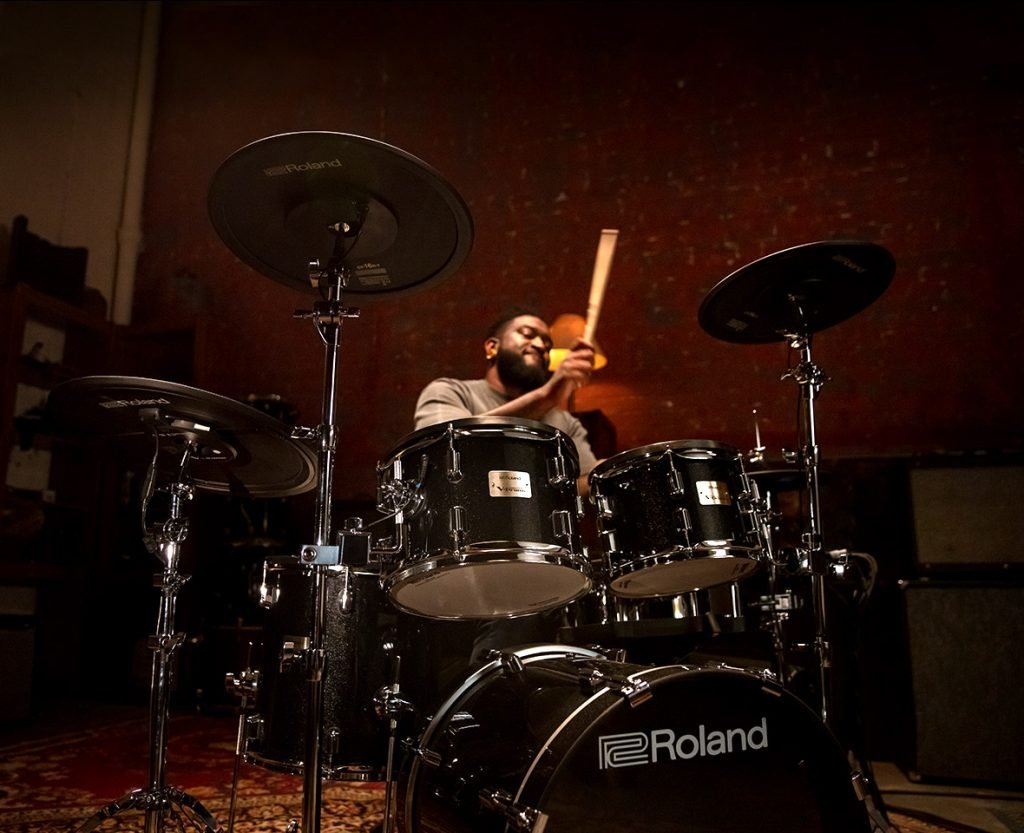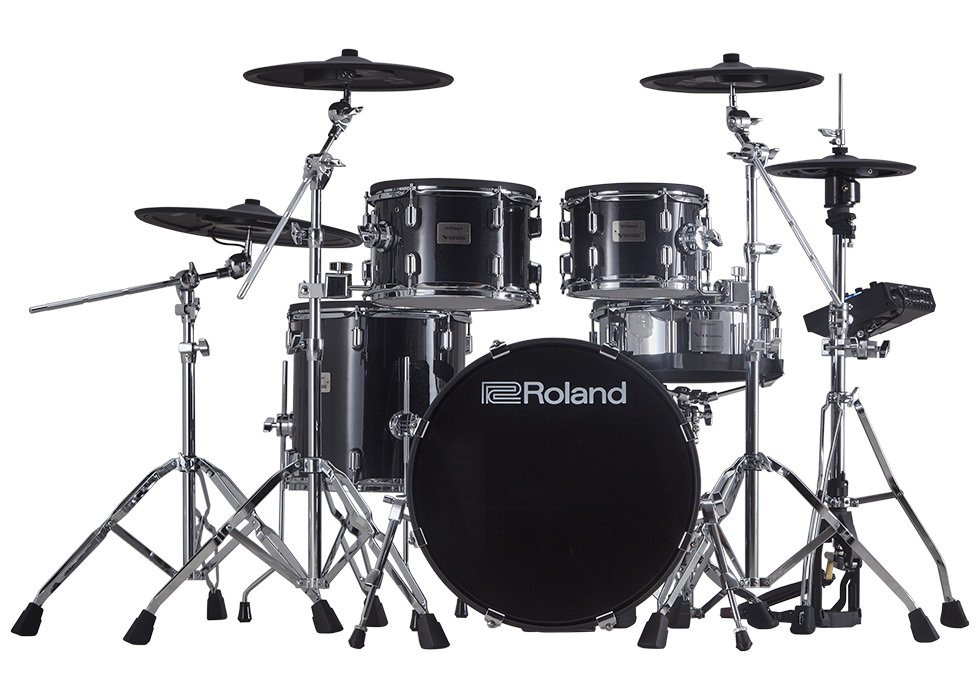In this article, we'll look at some ways to control the drum kit volume when drumming for worship by using electronic drums without missing anything.
The Ten Benefits Of Using V-Drums for Worship
-
Controllable Volume Level
-
Familiar Acoustic Drum Kit Look
-
Normal Acoustic Playing Techniques Possible
-
V-Drums are Easy To Amplify & Record
-
Backing Tracks and Click Available Directly In The Module
-
Silent Rehearsal & Stage Sound-checking Possible
-
Rubber Rims and Cymbals Mean No More Stick Breakages
-
Settings Can Be Easily Saved and Recalled for Reliable Sound
-
Use Your Own or Your Favourite Artist’s Drum Samples
-
Simple Plug and Play Expansion
Drumming quietly with intensity and building a worship friendly drum set is one of the biggest challenges for any worship drummer.
In fact, drumming in difficult spaces like a churches and halls is a major headache and earache for band members and the audience too.
Drummers learn early on that drums come to life when hit the right way with conviction. That seems to be at odds with what is required in a band scenario in a big live space.
Hit hard enough, the drum vibrates properly and the resulting soundwaves excite the space making for a big and impressive sound.
Read this first hand story of one church’s switch to electronic drums here
As drums are so loud for the drummer generally, knowing when it’s too loud for the audience is impossible. Finding the right drum level appropriate for singers, spoken voice and band is usually a painful case of trial and error.
Luckily, electronic drums help address the first problem of volume of drums in the worship environment pretty simply: You can play with the intensity you love and turn the volume level down!
Not having to play behind a huge plastic screen to control the sound is a great relief too for drummers making V-Drums the best drums for worship from this perspective alone.
Big playing decisions are never that easy though so here are the most common reasons why worship drummers often don’t want to use electronic drums in place of their acoustic drums:
-
1st Argument: Electronic Drums Don’t Look Like Acoustic Drums
-
2nd Argument: They Don’t Feel Like Acoustic Drums
-
3rd Argument: They Don’t Sound Like Acoustic Drums
1st Argument: Electronic Drums Don’t Look Like Acoustic Drums?
Really? For the general public and even seasoned pros, being able to pick an acoustic kit from an electronic one in a live setting is near impossible these days.
The VAD-506 shown has a full-sized KD-200-MS 20″x16″ kick drum and 14″ snare just like a conventional acoustic kit. The toms are 10″ and 12″ wood toms designed to look great but with construction techniques to give the best triggering unlike standard acoustic drum shells.
The crash cymbals are the latest 14″ CY-14CT and 16″ CY-16RT. These new cymbals are 40% lighter than previous trigger cymbals which gives them the feel and response of acoustic cymbals whilst being almost silent.
2nd Argument: Electronic Drums Don’t Feel Like Acoustic Drums?
Electronic drums have come along way since the diabolical, wrist-shattering, hexagonal shaped riot shields of the 80’s.
See Roland’s journey in innovation here
Roland V-Drums feature multi-ply, adjustable tension mesh drum heads that feel right without too much bounce. Built-in, unique trigger technology adjusts to the player and they are quiet enough to play at home all day.
Mesh head thickness is chosen to suit the drum with 3-ply standard on the PD-140DS snare and PDA-140F-MS floor tom. Thicker heads provide less bounce and even lower volume.
These advanced technologies are the result of decades of R&D and exhaustive testing and close working relationships with the who’s who of the world’s finest players.
Billy Cobham, Peter Erskine, Omar Hakim, Ian Paice, Gregg Bissonette, Jim Keltner, Chris Whitten, Malcolm Green, Johnny Rabb, Thomas Lang, Michael Schack, Craig Blundell, Chad Wackerman, Kai Hahto and countless other pros.
All of this work results in an amazing playing experience leaving nothing left to miss.
See how the CY-18DR stacks up against an acoustic ride here…
CY-18DR: The Real Deal Ride


The powered 18″ CY-18DR has an electro-static sensor system and it’s own CPU and connects to the TD-50 and TD-27 module via USB.
This ground-breaking electrostatic sensing system allows the module to analyse stick position, hitting strength, interval between notes and even the amount of skin contact.
In order to feel just like a revered classic ride cymbal, the profile and weight are carefully chosen to give a natural swing and ‘buttery’ stick feel.
Expressive Full-sized Snare Drum
As one of the most played parts of any kit, a responsive and great feeling snare is crucial and the focal point of the kit.
The PD-140DS is a 14″ steel snare drum with three-ply mesh head and unique trigger sensor system. You can even change the shell colour anytime without glue; The drum, like the matching PD-108 and 128 series V-Drums toms, features a unique quick swappable shell wrap system.
Again, like the CY-18DR ride, the Roland digital snare features an electrostatic sensor system for seamless playing.
The USB powered drum is able to sense when a hand is resting on it and automatically communicates this to the sound module for instant cross-stick playing without any button pushes.
See how the PD-140DS compares to an acoustic snare here…
Great Feeling Hi-Hat Standard
As the most played part of the drum kit, the hi-hat is also the instrument that the most difficult parts of the kit to get right.
The Roland V-Hi-hat was created over two decades ago in order to drummers to seamlessly transition to an electronic kit.
Worship drummers familiar with conventional acoustic hi-hats, may at first be sceptical but in reality, have no problem adapting to V-Drums.
See Roland’s drum and percussion history story here
The VH-13 hi-hat that comes with the TD-50KV and KVX kits has both top and bottom cymbals and sits on a regular stand. The super thin VH-10 comes standard with the TD-17KVX, TD-27KV, VAD-503 and VAD-506 kits.
As the edge and bow of the cymbal are active, V-Hi-hats respond to edge accents and bow taps like a conventional hi-hat so there’s no need to change your style.
An edge sensor even allows foot free jazz style hi-hat choking simply by squeezing the edge of the cymbal.
In addition to all these expressions, foot splashing and foot pressure are recognised.
Pushing down on the closed hi-hat naturally raises the pitch slightly just as with an acoustic cymbal.
See the following playing comparison with an acoustic hi-hat
Responsive Crashes
V-Drums crashes come in sizes from five to sixteen inches. These feature dual zones for crash versions and or three zones for the crash/ride combination triggers CY-13R, CY-15R & CY-16R-T.
These V-Cymbals swing like conventional cymbals and can be choked with a simple stick hold or hand mute grab.
Thanks to advanced interval sensing in the module, cymbal swells behave as you’d expect on an acoustic cymbal.
As the interval between the notes increases, stick attack slows down. This rounds-off the sound helping creating a smooth swell that responds markedly different from single kits.
See the playability of the crashes here…
Incredible Kick
The amazing playability of the KD-180, KD-200 and KD-220 kick triggers is a result of detailed analysis of why acoustic kick drums feel the way they do.
Aware that no trigger had ever felt quite like an acoustic kick with a pillow inside, engineers go to work on the kick trigger to end all kick triggers.
A combination of the right sized shell, floating head stretched across a bearing edge and a wide enough sweet spot for double kicks was required. See the breakdown of components here…

So how does it play? Check it out here…
3rd Argument: Electronic Drums Don’t Sound Like Acoustic Drums.
This is a very common criticism but what do acoustic drums sound like?
It depends on so many factors that need to be put into perspective.
There’s the player, the instrument, the room, the audience. Drums sound very different for the player compared to the audience too and this also depends on whether the kit is amplified/miked up.
Acoustic drum kit sounds in the studio through headphones are electrified anyway if you consider that microphones are required to capture the drum sound.
Every drum sound you’ve ever heard on a recording or live on stage has been electrified so really an electronic interpretation of a drum if you think about it!
Live drums in anything but the smallest of venues always require amplification too so they are hardly natural sounding.
Basically, with V-Drums, the miking and technical side has already been done for you. Simply connect headphones or amplifier to the module and you’re ready to play. Sample import allows you to load your favourite sounds to integrate into your setup.
In concert with Hillsong UNITED, Simon Kobler uses samples to enhance his live acoustic kit sound, triggering the kick and snare library sounds via his Roland SPD SX Sampling Pad and RT-30 series acoustic triggers.
“I like integrating electronics live for a couple of key reasons. When I first started using drum machines to facilitate electronic sounds, it added an extra element to drumming that made things fresh and exciting. I enjoyed the learning curve. Most importantly though, I loved being able to enhance the acoustic sound I provided my engineers. My kick and snare samples are blended together with my acoustic sounds to provide something much richer and I have the ability to achieve one complete sound that lives in a different space to what I could achieve with just a drum and a mic.”
Read the full interview with Simon Kobler and Peter James from Hillsong UNITED here
You too can even record and integrate your very own drum and cymbal sounds into your kit.
Just like an engineer would mike-up each drum to record or amplify, so too is this possible with V-Drums.
The TD-27 module has two direct and two main outputs you can route how you like.

Typically, kick and snare are routed to the direct outs with the main outs assigned to toms and cymbals. Breaking it up this way offers great control from front of house without using too many channels.
Taking it up a notch, the flagship TD-50, for example, has ten balanced outputs for stage box connection together with multi-channel USB audio and MIDI for simple recording.

Conclusion
If you are a worship drummer struggling with acoustic drums, help is close by.
V-Drums allow you to play with the enthusiasm you feel without having to compromise on look, feel or sound.
Try a kit today at one of your local V-Drums dealers.








